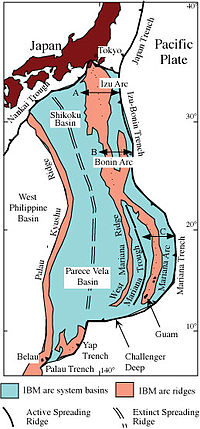
Photo from wikipedia
Abstract Changes in the dominant tectonic regimes and the modes of formation and maturation of the continental crust during the Precambrian are a subject of active debate. Here, we discuss… Click to show full abstract
Abstract Changes in the dominant tectonic regimes and the modes of formation and maturation of the continental crust during the Precambrian are a subject of active debate. Here, we discuss these issues in terms of new information on the crustal and lithospheric architecture of the different terranes in the Eastern part of the Indian Shield (EIS). We present well-constrained estimates of the crustal and lithospheric thickness characterizing different terranes of the EIS through the joint inversion of P-receiver functions (PRF) and fundamental mode group velocity dispersion data of Rayleigh waves (10–100 s). The lithospheric thicknesses are also computed independently using the S-receiver function (SRF) modeling. The study involved 2167 PRFs and 100 SRFs from 15 broadband stations. Our modeling detects a marked crustal (~4–8 km) and lithospheric (~15–20 km) thinning beneath the Singhbhum-Odisha-Craton (SOC), spatially correlating with the central part of the craton comprising the gneissic terrain contrasted by a crustal thickening (~2–6 km) beneath the horseshoe-shaped Iron Ore Group. We propose that such a crustal configuration beneath the Paleoarchean craton may suggest the dominance of vertical tectonic processes such as thickening of an oceanic mafic plateau and recurrent melting producing the TTGs and the Singbhum Granite suite. Infra-crustal reworking involving Rayleigh-Taylor instabilities and gravitational processes could explain the crustal architecture of the SOC much similar to a few other Paleoarchean cratons such as Pilbara (Australia), Barberton and Kappvaal (South Africa). Our modeling has also revealed a relatively smaller degree of crustal (2–4 km) and lithospheric thinning (4–10 km) beneath the Eastern Ghat Mobile Belt, south of the SOC. We observe a relatively thicker crust (~42 km) characterized by a flat Moho over a large area (~40,000 sq. km) encompassing the Chota Nagpur Granite Gneiss Terrane (CGGT). Such thickening is consistent with the convergence and collision tectonics involving the SOC and CGGT. However, we note a 15–20 km lithospheric thinning associated with the CGGT. Such thinning may mainly relate to Phanerozoic rifting along the Damodar graben and Rajmahal magmatism. Broadly, our model of the crustal and lithospheric architecture of the EIS reflects the imprints of northward subduction of SOC beneath the CGGT.
Journal Title: Precambrian Research
Year Published: 2021
Link to full text (if available)
Share on Social Media: Sign Up to like & get
recommendations!